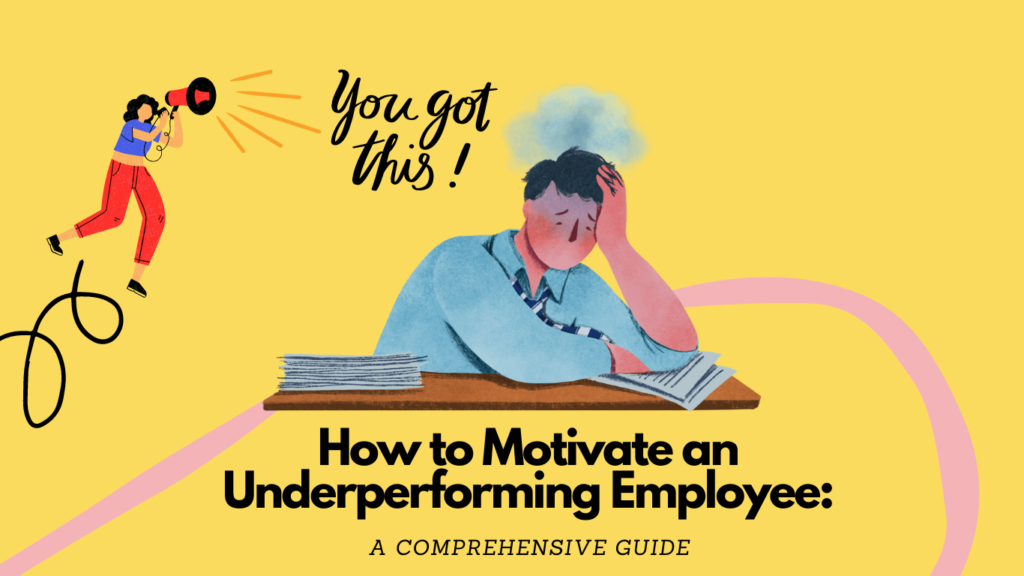How to Motivate an Underperforming Employee: A Comprehensive Guide

Ah! The never-ending quest of keeping your staff motivated. We know how difficult it can be to deal with an underperforming employee. They may be dragging down the rest of the team or taking up valuable resources that could be put to better use. In some cases, it may even seem like they are trying to sabotage your company.
It can be tricky to know how to handle the situation, but don’t worry – we’re here to help! In this comprehensive guide, we will discuss how to identify underperforming employees, how to start a conversation with them, and how to motivate them to improve their performance. Stay tuned!

Underperforming employees can be a drag on morale and productivity in the workplace. These employees consistently fail to meet the expectations in their job descriptions.
This can manifest in several ways, such as coming in late, taking too many sick days, not meeting deadlines, or not being a good team player. Yes, all this sounds very dreadful and negative! Therefore, it is important to take action to address the issue ASAP.
Before we dive into the topic, it’s important to understand the concept and value behind motivation: how do we ignite it? But most importantly, how do we keep that flame going, even under the most critical circumstances?
Motivation: An Outline
The word motivation derives from the Latin word ‘emovere’, which means to move. In essence, motivation is what causes us to take action; it is the driving force that leads us to achieve our goals.
Motivation is the process that initiates, guides, and maintains goal-oriented behaviors. It is what causes us to act, whether getting a glass of water to reduce thirst or reading a book to gain knowledge.
When motivated:
- Activation: We are driven by the decision to take action toward a goal.
- Intensity: We manage some level of energy and intensity with which we act.
- Persistence: We maintain this energy over a certain amount of time.

Maslow’s Theory and Motivation
Yet, motivation sometimes is not that simple. In order to understand how to motivate an underperforming employee, it is important to have a firm grasp on motivation itself.
Most of the time, we think motivation comes from within ourselves. However, Maslow’s theory suggests motivation is driven by a hierarchy of needs.
Abraham Maslow was a psychologist who proposed a theory consisting of five different types of needs that motivate us. This theory is often presented as a pyramid, and as we satisfy each need, we move up to the next level.

From the lowest level to the highest needs:
Physiological
These are the most basic needs such as air, water, and food. Once these needs are met, we can move on to the next level.
Safety
These are the needs for security and safety. Examples include a stable job, health insurance, and a safe place to live.
Belongingness and Love
These are the needs for love, friendship, and belonging. We need to feel connected to others to satisfy this need.
Esteem
These are the needs for self-esteem and respect from others. We need to feel good about ourselves and have the esteem of others to satisfy this need.
Self-Actualization
This is the need for self-fulfillment and personal growth. Once we have met all of the other needs, we can focus on this one.
However, it is important to keep in mind that not everyone is motivated by the same things. You need to take the time to get to know your employees and what drives them!
When employees’ needs are not met they start to underperform. For example, employees are less likely to be motivated if they do not feel valued or cannot see how their work is making a difference.
Motivation: Two Types.
When settling a plan to motivate underperforming employees, you need to choose which type of motivation fits you.
There are two main types of motivation: intrinsic and extrinsic.
- Intrinsic motivation comes from within ourselves; it is the desire to do something because we enjoy it or because we believe it is important.
- Extrinsic motivation, on the other hand, comes from external factors; it is the desire to do something because we want to avoid punishment or because we want to receive a reward.

Take into account that intrinsic motivation is more powerful than extrinsic. After all, who would want to be motivated just because by doing so, you avoid punishment?
Extrinsic motivation often leads to a short-term increase in performance; however, most of the time, it does not lead to long-term sustainable change.
To motivate underperforming employees, managers should focus more on building on intrinsic motivation
Cho and Perry (2012) found that intrinsic motivations have three times the impact on employee engagement levels as extrinsic motivations. Intrinsic motivation was found to be positively associated with employee satisfaction.
And, predictably, adversely associated with the employee’s intention to quit. That correlation became significantly stronger when there were higher degrees of managerial trustworthiness and goal orientation.
We could think the workplace is driven by extrinsic motivation such as the desire to meet certain goals of earning a promotion or receiving a pay raise. Yet, it can be difficult to maintain high motivation levels in the face of challenging tasks or frustrating co-workers. This is where intrinsic motivation gets relevant!
Finding Out What Motivates an Employee: The Key to Success!
Sometimes the journey of identifying what is demotivating your employee can be counterproductive. It can be difficult to find out what intrinsic motivators work for each individual.
Some underperformers may not want to share their feelings or may not be aware of what drives them. In these cases, a great way to start this conversation is by asking them what they enjoy doing and what they are passionate about.
You could also look for clues in their behavior. Do they take pride in their work? Are they always looking for new challenges? These are signs which can help you understand what intrinsic motivators may work for them.
For example, O.C. Tanner questioned employees in a recent employee survey: “What drives exceptional work?” To which employees answered in their own words that recognition was the most significant consideration for 37% of respondents.
This is far from extrinsic motivation!

When you know what drives your staff, you will not need to force them into meeting deadlines or increasing their productivity levels as they will be driven by themselves!
How to Motivate an Underperforming Employee: A Comprehensive Guide
However, let’s breach the subject at hand; let’s discuss how to motivate an underperforming employee! As we stated before, it can be tricky to know how to approach the situation.
Do you give them a verbal warning? Do you write a formal letter? Do you have a meeting with them? The answer is: it depends. It depends on the severity of the issue and on the relationship you have with the underperforming employee.
Follow our guide!
Before attempting any solution:
- Understand that your underperforming employee may not be aware of their poor performance! If this is the case, you need to have a conversation with them.
- You should avoid coming across as confrontational or accusatory; instead, try to frame the conversation as a way to help them be successful.
- It is also important to avoid making assumptions about why they are underperforming; instead, ask them directly if they are struggling with anything at work.
Is Your Workplace Toxic?
The first step is to take a step back and analyze your workplace. Is it possible that the underperforming employee is struggling because of the environment they are in?
It’s important to create a positive work environment where employees feel valued and appreciated. If you think your workplace might be toxic, there are some steps you can take to fix that. The following are some signs that your workplace might be toxic:
- Employees are constantly complaining.
- There is a lot of negative gossip going around.
- Employees seem withdrawn and unhappy.
- You have high turnover rates.

If you notice any of these signs in your workplace, it’s crucial to take action and address them accordingly!
Know What You Want From The Employee
The next step is to sit down and figure out what you want from the underperforming employee. What are your expectations? What goals do you hope they will achieve?
It’s important to be clear about your expectations from the start so there is no confusion later on. Once you know what you want, you can start working on a plan to help them get there!
Identify The Problem
Then, if you are clear about what you want from the employees, try to identify the problem. Does the underperforming employee not understand your expectations? Or are they not meeting the expectations of their co-workers?
Try to figure out what is causing the underperforming employee’s lack of motivation. There could be any number of reasons why they may be underperforming, and it is essential to identify the root cause before you can start working on a solution.
Some common causes of underperformance are:
- Lack of training or development
- Unclear expectations
- Poor work/life balance
- Stress
Consult With A Manager
If you are struggling to come up with a solution, it may be helpful to consult with a manager or supervisor. They may have more experience dealing with underperforming employees and can offer some valuable insight.
Get Feedback From The Employee
Lastly, it’s also important to get feedback from the underperforming employee. They may have some input on what is causing their lack of motivation and how to best address the issue.
Taking the time to listen to their concerns can help build trust and improve communication. It also shows that you are invested in helping them. We know underperforming employees can be frustrating, but remember that they are people too.
Don’t forget to show empathy and compassion when dealing with underperforming employees
Once you have identified the problem and consulted with a manager, it’s time to start working on a solution. Here are some best practices for managing an underperforming employee:
Encourage Self-Reflection
It can be helpful to encourage the underperforming employee to do some self-reflection. This can help them identify any areas where they may be falling short and what they need to work on.
Tap Into Their Talents and Interests
One way to motivate underperforming employees is to tap into their talents and interests. If you can find a way to connect their work with their passions, they will be more likely to be engaged and motivated.
For example, if an underperforming employee is passionate about writing, you could assign them tasks that involve writing or give them opportunities to contribute to company blog posts.
Set Realistic Goals
It’s important to set realistic goals for the underperforming employee. If the goals are too high, they may feel discouraged. But if the goals are too low, they may become bored or complacent.

The key is to find a balance and challenge the underperforming employee without setting them up for failure.
Be Clear About The Consequences
If an underperforming employee doesn’t shape up, there need to be clear consequences. This could mean anything from a verbal warning to being let go from the company.
The key is to be clear about the expectations and the consequences from the start. That way, there is no confusion later on down the road.
Encourage Positive Reinforcement
It’s important to encourage positive reinforcement when working with underperforming employees. This means finding ways to praise them when they do something well, no matter how small it may seem.
Giving positive reinforcement will help the underperforming employee feel appreciated and motivated to continue doing good work.
Develop a Plan Together
Sit down with the employee and develop a plan together. This shows that you’re invested in their success and are willing to work with them to improve their performance.
Start by identifying the areas where they need to improve and setting some realistic goals. Then create a timeline for meeting those goals and agree on what support they’ll need from you.
Finally, check in regularly to see how they’re doing and make adjustments as needed!
Be Patient
Give your underperforming employees time to improve! They may not turn things around overnight, but if you are patient and continue to support them, they will eventually get back on track.
Final Thoughts
We hope this guide helps understanding how to motivate an underperforming employee. Remember, every situation is different so it’s important to tailor your approach accordingly. With patience and creativity, you can find ways to help even the most underperforming employees succeed!


